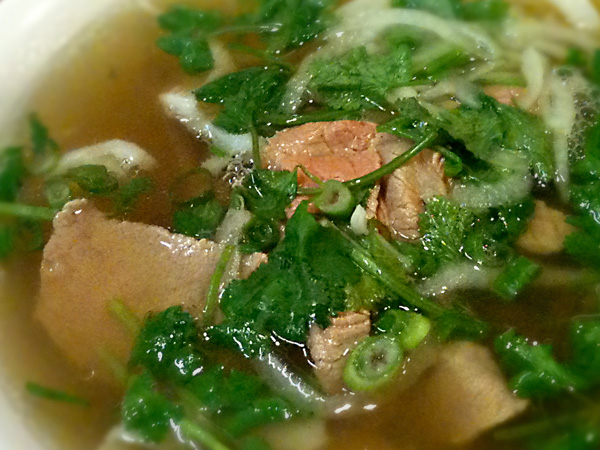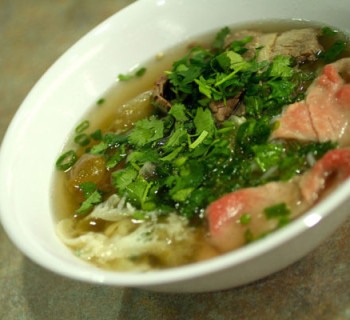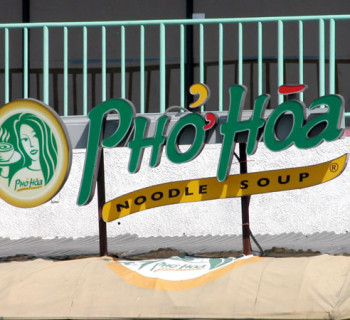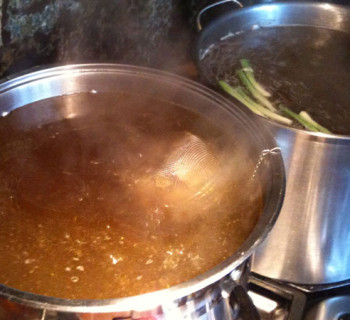Updated 04-12-19.  You have a pho recipe and making your own beef pho broth at home is relatively easy. However, there are some easy missteps that can mess you up fast, regardless of how closely you may follow your pho recipe. In this article, I provide a collection of simple yet important things you can do to ensure big success with your next beef pho broth. Many of these are included in various different pho recipes, but here they are in one place for quick and easy reference.
You have a pho recipe and making your own beef pho broth at home is relatively easy. However, there are some easy missteps that can mess you up fast, regardless of how closely you may follow your pho recipe. In this article, I provide a collection of simple yet important things you can do to ensure big success with your next beef pho broth. Many of these are included in various different pho recipes, but here they are in one place for quick and easy reference.
Looking for a solid beef pho recipe? Check out Lovingpho’s own Beef Pho Recipe infographic.
Parboil the bones and meat properly
In order to achieve a good quality, pure, clear and flavorful broth, you really don't want to skip the parboiling part. Sure, it will add an extra 30 minutes or more to your cooking time, but this is the only way to get most of the impurity out of the raw bones and meat before your actual broth making begins. Pay attention to these steps:
- Measure about the same volume of water as bones and meat into your pot. Bring water (alone) to boil.
- Then carefully place the bones and meat in. Bring the water back to boil as fast as you can, and once boiling, parboil for 3-5 minutes to release impurities. Some recipes call for low boiling water with a little longer time. This is fine if you have the time to do it.
- At the end of parboiling, discard the water and rinse the bones and meat to wash away the scum and other floating solids.
- Boil a new pot of clean water then put in the bones and meat. Your broth making starts at this point.
- Note: If you have room on your stove, to save time, it's a good idea to boil water for broth in a second pot. This way, the bones and meat can go right in after rinsing.
Give plenty of time to cook the bones and meat
One reason we eat out is the convenience factor. For the many who want to make their own pho at home, there is no such thing as convenience, and patience and time are the real key. You cannot rush broth making, and you cannot rush the time required to extract flavors from bones and meat. So be sure to give yourself plenty of time, in the range of 3-5 hours, to get as much flavor out as possible. Commercial restaurants may have their own ways to making broth in either shorter time or with much larger quantity, or both. These techniques may not be practical to apply for home cooking, but if you're an aspiring restaurateur wanting to know more, please drop me a note in the Pho Restaurant Consultation page.
Temperature control
For the most flavorful and clear broth, your pot needs to be in a constant simmer. Take your time in the first 15 minutes or so to make adjustments to your temperature. This ensures that you have true simmering in the next 3-5 hours; no rolling boiling water, no dead still water either. You want to aim for water having active movement and some rolling is ok, as long as the surface does not break or water is not splashing in the pot, producing big steam above your pot. Once you have stable simmering, you can move on to do something else. Many people miss this part, then have to rush back to adjust the temperature. The damage has been done by then.
Skim the scum
Regardless of how well the parboiling was done, you'll always have to skim the scum floating while the broth is simmering. Don't skip this step, otherwise your broth will be murky and yucky. There are various skimmers you can use, such as described by Andrea Nguyen's article on Skimming Scum Made Easy.
Do the spices right
Whatever spices are called for in your recipe (star anise, cardamom, cloves, etc.), it's best to roast them before putting in the broth. Variations abound, but a quick, easy and effective way is to just roast them in a open sauce pan or in an oven. You want to lightly heat and char but not burn them, so keep watch. Adding heat will release lots flavors and fragrance than using the dried spices straight from the package. Tie them up in cheesecloth before going into the broth for easy extraction later. Here are some posts discussing pho spices in more detail: Is It More Than Just Spices That Make Real Pho?, How Long To Cook Pho Spices In Pho Broth, How Best To Add Spices When Making Pho Broth?
Go easy on the fish sauce
Many beef pho broth recipes call for adding fish sauce toward the final tasting phase. Anyone working with fish sauce knows it's strong stuff and can be easily underestimated (overpour). It can kick up tremendous flavors and add big umami, and you can easily misestimate the amount you put in. So go lightly at first, give a taste, and you can always add more later. Actually, you shouldn't have to use too much fish sauce in your pho broth.
Leave the fat
When done right, all beef pho broth will have a layer of fat covering the surface. These globules of goodness add great beefy flavors to the broth and retain a lot of the spice flavors that make this a pho broth and not just regular beef stock. Regardless of how "healthy" you want to aim for, do not skim and throw away this layer of fat. You can always stir lightly and exclude the fat as you ladle broth into your bowl as you serve. One other advantage the layer of fat will give you is it protects your broth from interacting with the air, thus preserving your broth quality even as you later store the leftover in your cooler.
I hope these little tips and reminders help your next batch of pho broth to be a great one. Do you have other challenges with your pot of pho? Or maybe you have tips to share? Drop a comment below, yeah?




In the section leave the fat. I learned something new that with the added layer of fat it protects the broth from the air which means sense. Air increases oxidation and breakdown which for soup we want to keep its flavor as long as possible. But if I owned a restuarant I prefer to remove this layer of fat because achieving consistency is easier when removing this fat. I just freeze cooked soup overnight and ask staff to remove the fat. I watch Madame Vo owner on YouTube and he recommends adding some oil into the final bowl when serving. While I agree adding a bit makes it taste better but according to some yelpers the soup was too oily and they can taste the oil more than the soup. And I’ve seen this happened at a few places where the oil is so much it seems they didn’t even do any skimming or taste like it’s leftover. It seems in terms of achieving consistency its better to have staff remove this as part of the cooking process rather than adding it more oil or leaving in some oil. Pho filet soups are very clear and with no sight or hint of oil and it taste just as good or even better. Also I think less oily broth has the added benefit of appearance and in keeping with the healthy trends.
@Vincent: I think you may have mixed up between the fat resulting from cooking the proteins, and the raw cooking oil added just before serving. The two are not the same and are not comparable. The former is totally legit cooking practice, but the latter is questionable at best.
Fat layer protecting the food underneath, as discussed in this post, is a well known practice/technique in Viet, Chinese and European cooking. It’s similar to aspic or meat jelly dishes that are served in many cuisines. Examples of Vietnamese aspic include Thịt Đông (Jellied Pork), some Bò Kho (Viet Beef Stew) if lots of tendons are used, and Bún Bò Huế broth where lots of tendons and pig feet are used. Storing these in a cooler will turn them into aspic with layers of fat on top. Each individual dish has its own way of service including heating or not heating before serving. Obviously heating the jelly will turn it back into liquid broth form. We eat Thịt Đông cold, but if for some reason it’s heated then you’d get a fatty pork broth-like solution/soup. For pho, the broth does not have as much gelatin in it so it does not turn gelatinous state but the fat layer on top is pretty much the same concept.
One very important note for restaurant pho is that the tendons are never cooked/simmer together in the pho broth. Tendons are always cooked separately in restaurant environment. If we cook tendons together in the broth, then the collagen will come out as gelatin, making the broth murky and turning it into aspic.
Regarding adding raw oil to pho: I’m not sure what people are trying to achieve, but I think it’s ill advised. I see people use all kinds of tricks in an attempt to make their pho better/different from someone else’s. But this is one bad practice.
In the culinary world and for more well known cuisines, the only times when uncooked oil is used during service are 1) in Western salad dressings and 2) extra virgin olive oil in some Italian dishes, with the condition that a good quality oil is used. In no other instances of food service, Vietnamese or other food type, is use of uncooked cooking oil appropriate. Adding oil to a bowl of pho just before serving is definitely not recommended, whatever purpose this is intended to achieve. So I agree with you, even though our reasons may be different, that adding oil to pho is not a good practice.
Wow I’ve never heard of people adding oil to a bowl of pho before serving. That’s kind of yucky. I’m not eating it if they do that. We know pho broth should not be murky when serving, my opinion is if people would spend some time to learn good cooking techniques and do it right, then they would not need any fixing “technique” afterward, whether it’s too murky, too oily or too dark etc. My mom and aunts spend a lot of time caring for their pho pots when making pho and the result were always the clearest and tastiest broth.
Is there a fix for pho that had too much cinnamon added? Tastes like cinnamon soup!
@traci bailey: Hmm there may be a way to fix depending on the quantity you’ve made. If we take your words for it that it tastes like cinnamon soup, then as you said, way too much cinnamon was used. At this time it may not be worth it to try and salvage it.
If you really really want to try, then it will require simmering in more water as you add more of the other ingredients to balance things out. Depending on what you have to start with in the pot, the trick pretty much boils down to (yes, pun intended!) doing trial and error on a) how much water to add, b) simmer time, c) ingredient amounts, and d) knowing when to stop. So as I said, best to start over. Best of luck whichever route you take.
Too much sugar rock made my pot too sweet. How do I neutralize this or make it less sweet?
@Chloe: Unfortunately if you have added too much rock sugar during the cooking, then there’s not much can be done once the whole cooking process is over. It’s probably best to freeze and save this to mix a little bit each time to a new batch you will make, or just consume it now if you don’t want to throw it away. That said, you may be able to “neutralize” the problem depending how sweet is “too sweet” according to your taste, by diluting the “too sweet” broth with water to ease up on the sweetness then adding a little more salty and spice elements to your taste while reheating the whole pot at once or reheating portions at a time for consumption. This way you may be able create a more acceptable result rather than throwing out the whole thing. The real way to fix this is never repeating the mistake again 😉 Best of luck.
What can I do to neutralize the fish sauce I put in my pho?
@Mary Lou Guerrero: By “neutralize” I’m assuming you’ve put too much fish sauce in the pot and now would like a way to somehow “reduce” its effect? If so then I think you may be out of luck. There’s not much you can do unless you want to dilute it.
I just got back from Vietnam and I’m attempting to make something resembling the amazing pho I tasted there. I spent all day on the broth, and while it tastes pretty darn good for my first try, it seems like there is just too much fat on the surface. I don’t recall that much fat in the pho we tried in Vietnam (in several cities from Hoi An to Saigon). My husband suggested we should have trimmed the fat off the brisket before making the bone broth, which I did not do as I followed my recipe exactly and it didn’t mention this step. I also see mentioned that there should be some fat on the surface. Thoughts on that? Thanks for the great info!!
Update – I skimmed the hard fat off the top when I took it out of the fridge this morning, and tried again. It’s much better texture-wise but it did lose some of the flavor with the fat, so I added a little more fish sauce.
@Liz: It all depends on what you want.
In general, meaning for any type of food, a large part of the flavor in a broth or soup exists in the fat globules that float in the liquid and on top of it. When hot, you get a better and more consistent mixture of liquid and fat in every ladle, but you can see that much of the fat does float on top (looks like clear oil when hot, opaque white when cold). During the cooking process, you can skim off the scum but do try to leave the fat. When cold, the fat forms a thicker/white layer over the liquid. This is true for all soup stock and broth made from animal products.
It should be okay, actually recommended, to leave the fat layer. It will protect your liquid underneath from interacting with the air, helping to seal in the flavors and slow down spoilage during storage. For consumption, it’s pretty easy to ladle just broth (if you want little fat) or broth with more fat into your bowl. It’s in the way that you use the ladle to gently mix the broth, how deep you go into the pot, and how fast you lift it out into your bowl. The slower you go up breaking the surface during lifting, the less fat gets push out of the ladle, and the more fat you get into your bowl. For even more fat, one can “chase” or skim to add more of it as you ladle. Restaurants do this thousands of times everyday for customers who want either less fat or extra fat, from the same pot. So it’s all in the technique.
You should see what restaurant pho pots look like before serving to customers. I’m pretty sure they didn’t throw away all the fat and flavor goodness.
You’ll get better with time as you make more pho. Enjoy.
@Liz: By the way, removing the fat layer and adding more fish sauce isn’t really a good solution. But I’m sure you know this, as you mentioned, it removes flavors and adds saltiness. It’s a good fix for emergency situations or for testing things out, but it’s not a good long-term practice. Also trimming fat off the brisket can work, but again you do need the fat for flavors.
Side note: Restaurants that I give consultation to use various different techniques to lower fat and retain/add flavors. All of them require newly developed or adjustment to recipes, and often there are additional costs in both the processes and ingredients.
For me, if you have achieved the flavors you like, and the only problem is the amount of fat floating on top, then the easiest solution is to learn ladling technique to get what you want. This way you don’t “artificially” fix your problem and compromise your pho quality doing it.
Thank you Cuong! That makes total sense about leaving the fat and controlling it through ladling as needed. Today I’m going to try making pho ga with a whole chicken – and this time I will not skim the fat. Thanks again! -Liz
Awesome Liz. If you’re making chicken pho then here are a few helpful tips:
– You can half or break the carcass down to more manageable sizes so it’s easy to drain, move around, manipulate, etc. Preferably, break down the carcass to mostly meat parts and bone parts. The meat parts should cook quickly (compared to beef) and be extracted for serving later, while the bone parts can simmer longer for flavors.
– You can extract chicken/chicken bones flavors much quicker than beef/beef bones, so an hour or so of cooking should be long enough. In general, you want to adjust your recipe (and write it down so it’s repeatable or improved upon) for pho ga.
Not sure how you bought your whole chicken, but a good option is to buy your dark and white meats as you would normally buy chicken as, and separately buy chicken bones for the stock. Hope these help.
Every time I have made pho the broth just tastes like hot water with spices added. It doesn’t have that deep beef flavor. M making it now and it’s only been maybe 2.5 hours. I will do another 2.5 but I’m worried it will still taste like hot water with spices. The saltiness is good. The spices r good. Just the base is like water. I’m using leg bones , neck bones and knuckle bones. About 4.5 pounds of bones for 6 qts of water… help! Lol
@Amanda Rivera: Without seeing your recipe and your process, it’s hard to tell why your broth “tastes like hot water with spices added”. You mentioned a lot of different bones, but did you also include any meat cuts, maybe flank and/or brisket, or chuck roast? Fact is you can’t get beef flavors for pho just from bones alone.